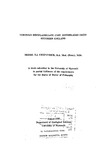TURONIAN DINOFLAGELLATE CYST ASSEMBLAGES FROM SOUTHERN ENGLAND
| dc.contributor.author | FITZPATRICK, MERIEL E. J. | |
| dc.contributor.other | School of Geography, Earth and Environmental Sciences | en_US |
| dc.date.accessioned | 2011-09-29T12:46:03Z | |
| dc.date.available | 2011-09-29T12:46:03Z | |
| dc.date.issued | 1992 | |
| dc.identifier | Not available | en_US |
| dc.identifier.uri | http://hdl.handle.net/10026.1/790 | |
| dc.description | Merged with duplicate record 10026.1/2029 on 13.20.2017 by CS (TIS) | |
| dc.description.abstract |
Little recent work has directly addressed the variation in dinoflagellate cyst assemblages and the resulting biostratigraphy from the Turonian of southern England. Sampling (every 1-2m) of the whole succession from three areas (Dover, Sussex and the Isle of Wight), together with sedimentological and macropalaeontological detail provided a good basis for what is primarily a biostratigraphical study. Altogether 328 samples were analysed. It is one of the aims of this project to expand on the knowledge and geographical limits of dinoflagellate cyst assemblages from the Turonian. Full descriptions of all dinoflagellate cyst species have been included. Two new species are believed to have been noted, first Litosphaeridium "chlidanum" n. sp. (Marshall, 1983) and ? Microdinium "tuberculatum" n. sp., which are indicators of a latest Cenomanian and Turonian age respectively. Three palynozones have been recognised for the Turonian, based upon the ranges and acmes of the following species: Senoniasphaera rotundata, Heterosphaeridium dilltile, Florentinia buspina, Florentinia torulosa and Endoscrinium campanula. Cluster analysis was applied to the data sets to look for statistically related samples and thus separate palynozones. However most of the dinoflagellate cyst species are long-ranging and this did not provide any substantial evidence for any zones. Generally the dinoflagellate cyst assemblages were of variable diversities and abundances (0-41; 0->300 respectively). The samples were barren or yielded poor assemblages at the base of the Turonian, but the flora recovered towards the middle part of the succession with increasing diversities and abundances being recorded. However, the high diversities and abundances of the Late Cenomanian were never achieved. Samples of chalk, marl and flint were analysed for their dinocyst content to see if the assemblages were lithologically constrained. It was found that the lithology did not appear to control the cyst assemblages with low to high diversities and abundances being recorded from all lithologies. It has been noted that particular types of flint (Thalassinoides) may produce richer dinoflagellate cyst assemblages (higher diversities and abundances) which may be related to the diagenetic stage represented by the flint. Statistical analyses were applied to all data sets to provide evidence to support these hypotheses. Unfortunately these methods did not produce any conclusive results. Some palaeoenvironmental interpretation has been carefully attempted using modern analogues as a guideline. The relative occurrence of three groups (Gonyaulax, Odontochitina and Cyclonephelium) have been plotted for two of the areas (Dover and Sussex) and are thought to reflect periods of changing sea-level which correspond broadly to the sea-level curves of Hancock & Kauffman (1989) and Haq et al. (1988). | en_US |
| dc.description.sponsorship | BRITISH GEOLOGICAL SURVEY | |
| dc.language.iso | en | en_US |
| dc.publisher | University of Plymouth | en_US |
| dc.title | TURONIAN DINOFLAGELLATE CYST ASSEMBLAGES FROM SOUTHERN ENGLAND | en_US |
| dc.type | Thesis | |
| dc.identifier.doi | http://dx.doi.org/10.24382/4842 | |
| dc.identifier.doi | http://dx.doi.org/10.24382/4842 |
Files in this item
This item appears in the following Collection(s)
-
01 Research Theses Main Collection
Research Theses Main


